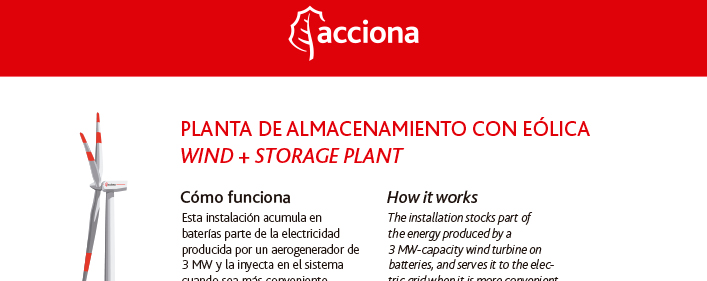- The plant will use software to simulate storage systems with renewable energy, for which two company’s engineers have been awarded the ‘Eolo Innovation’ award for 2017 by the Spanish Wind Energy Association (AEE)
- Located next to the experimental wind farm at Barasoain (Navarra), the plant will apply technological storage solutions that will be applied to the commercial wind farms
ACCIONA Energía has started up the first hybrid plant for storing electricity in batteries that is part of a grid-connected wind farm in Spain. The company has also developed simulation software that will be used in the plant, for which it has been awarded the ‘Eolo Innovation’ prize for by the Spanish Wind Energy Association (AEE). These two projects make the company a pioneer in this kind of solutions, aimed at facilitating the integration of variable-generation renewables into the grid and optimizing the management of the power produced.
Located in Barasoain (Navarra, northern Spain), the plant is equipped with a storage system consisting of two batteries located in separate containers: one fast-response 1 MW/0.39 MWh power battery that can maintain 1 MW of power for 20 minutes, and another slower-response battery with greater autonomy of 0.7 MW/0.7 MWh that can maintain 0.7 MW for 1 hour. Both batteries are of Li-ion Samsung SDI technology and are connected to a 3-megawatt rated capacity AW116/3000 wind turbine of ACCIONA Windpower (Nordex Group) technology. The batteries will store energy produced by the wind turbine when required. The turbine is one of five that make up the Barasoain Experimental Wind Farm, which the company has operated since 2013.

The installation also has three other units: one for medium voltage cells and analyzers, another for inverters/chargers and a transformer (installed by Ingeteam, a company participating in the project), and a third for the control and monitoring equipment.
In the plant, grid-connected storage solutions will be put in practice in order to provide advanced technology services aimed at improving the quality of the energy sent to the grid. Other applications will also be analyzed, such as ancillary services to the electric power system – necessary to maintain a continuous balance between supply and demand – or the energy supply shift to match the production to periods of higher demand, which improves the economic performance of the installation.
The project has received funding from the European Regional Development Fund (ERDF), which manages the Spanish Centre for Industrial Development (CDTI).
See infographic

Optimizing storage
A key element of the innovation work carried out by ACCIONA in this field is the simulation software developed in-house. It means that storage systems can be dimensioned and optimized in synchronization with wind farms, whether they are in the project phase or fully operational.
Bearing the Spanish acronym ‘ADOSA’ (Analysis, Dimensioning and Optimization of Storage Systems), it is an innovative tool with the special feature that it covers technical, economic and strategic aspects in an integrated way, meaning that the optimal solution can be found for each case.
The Spanish Wind Energy Association has just awarded its top prize in the field of R&D – the Eolo Innovation prize – to this project, the brainchild of engineers Asun Padrós Razquin and Raquel Rojo Ochoa, who work in the Innovation Direction of ACCIONA Energía.
Expectations for the future
The application of electric power storage systems using batteries connected to wind farms and solar plants is a field with great growth potential due to the major development of renewable energies worldwide, lower battery technology prices and improved efficiency.
Although still in an early phase, this kind of solution is demonstrating that it is ideal not only for domestic applications or grids with poor connections (islands, weak grids) but also for utility-scale applications in developed countries, with a focus on increasing the penetration of variable renewables in power grids without losing quality or security, and on adapting electricity supplies at times of higher demand. Basically, it is about improving the flexibility of electric power systems to incorporate greater renewable capacity, in a context of a shift towards a low-carbon energy mix in which fossil fuels will be gradually replaced by clean technologies.
According to the International Renewable Energy Agency (IRENA), battery storage is even better for providing a fast response to electric power system regulation demands than conventional fossil fuel plants, which have traditionally provided these ancillary services.
Analysts expect strong growth in storage systems over the next few decades. The consultancy firm Navigant forecasts revenues in utility-scale projects of 18,000 million dollars in 2023 against 220 million in 2014, a period in which the annual storage capacity in batteries will go from 360 MW to 14,000 MW.
Según la Agencia Internacional de Energías Renovables (IRENA), el almacenamiento en baterías se muestra incluso más ágil para dar respuesta rápida a los requerimientos de regulación del sistema eléctrico que las plantas convencionales de combustibles fósiles, que prestan tradicionalmente estos servicios de ajuste.
Los analistas prevén un importante crecimiento de los sistemas de almacenamiento en las próximas décadas. Sólo en proyectos a escala “utility”, la consultora Navigant prevé una facturación de 18.000 millones de dólares en 2023, frente a 220 millones en 2014, período en que la capacidad anual de almacenamiento en baterías pasará de 360 MW a 14.000 MW.